The Sanctuary of Truth
@Asim Deb
You may call it a spiritual site without any religion, or You may call it the world’s largest woodcraft structure themed on the Buddhist and Hindu beliefs, and a structure of only wood and wood, that didn’t use a single nail. It was/is not built to spread any particular religion, but to share the message of spiritual unification of different religious thoughts into a single belief: peace and love for all.
“Who are we, where did we come from? how to live? how will life go on? and what is the purpose of life?”
Passing through the ‘Prasat of the Truth’ Museum’, the largest wooden castle in the world at Laem Ratchawet, Na Kluea Subdistrict, Chonburi Province, here people are invited to find the meaning of life. Its Thai name is Prasat Satchatham, with “prasat” meaning “castle” and “satchatham” meaning “philosophy”. It is constructed according to ancient Thai ingenuity to withstand wind and sunshine on the seashore. To the international world it is known as The Sanctuary of Truth. The museum structure is themed on the Ayutthaya Kingdom’s Buddhist and Hindu beliefs. And the structure is decorated with Thai, Hindu, Buddhist, Chinese, and Khmer ornamentations and traditions.
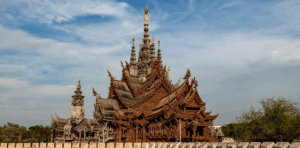
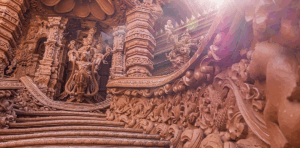
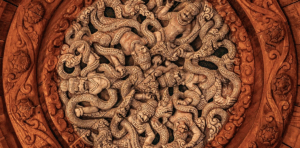
The Sanctuary of Truth covers an area of 13 hectares of land (more than 3,200 sq. meters), the temple houses an internal space of 2,115 m2, with the tallest spire reaching 105 m (344 ft.). The height of 105-meters with its spires reaching towards the sky, is symbolizing the eternal communication between heaven and the earth.
The splendid attraction will be the beauty of a wooden sculpture carved with only wood, using the ancient Thai art and technique of attaching woods instead of using nails. Carvings are inspired by the art of East Asia that have been blended together until become the unique art of the museum and about philosophy life meaning Morals and ideas that are not attached to any religion is a philosophy that is universal and can be applied in daily life. Considering Ayutthaya Kingdom’s Buddhist and Hindu beliefs, main focus is to visually portray important eastern religious concepts and the cycle of life, with only wood-carved idols and sculptures. Neither a temple nor a palace, despite looking like a hybrid of both, it was commissioned as a place of appreciation for philosophy, art, culture and faith, without being tied to any single religion.
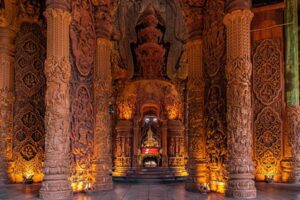
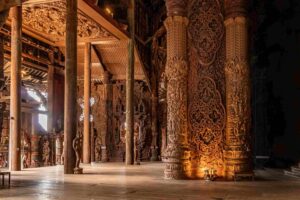
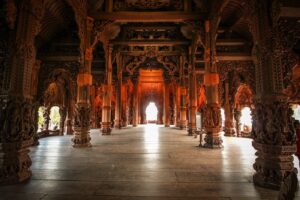
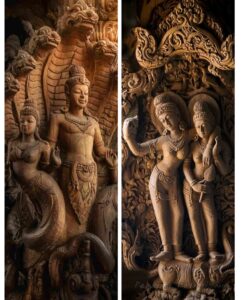
The Sanctuary of Truth is one of the most unusual and photogenic buildings in Buddhist regions. In doing so, the highest point is over 100 meters, and you can admire it from afar. It is impossible to capture the atmosphere, the beauty and the small details in a photograph, you have to see the Sanctuary of Truth for yourself when you are in Pattaya! Interestingly the temple has hundreds and thousands of minute artworks that are all handmade.
The temple has a celestial view of the ocean, it is best described as a visionary environment consisting of art and craftsmanship, religious shrine and cultural monument. Its four wings are each dedicated to a religious iconography: Thai, Khmer, Chinese and Indian. Through elaborate carvings and sculptures; and pays tribute to the seven creators that man cannot exist without: Heaven, Earth, Father, Mother, Moon, Sun and Star.
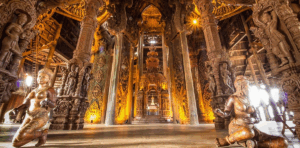
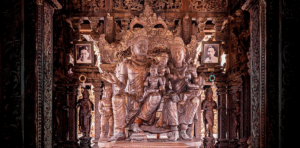
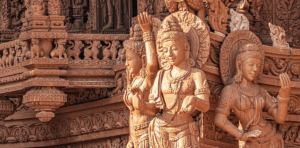
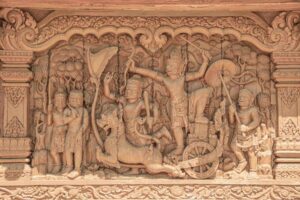
Architectural Marvels and Symbolism
The Sanctuary of Truth is showcasing the seven truths of life by the following
• First Truth: “Who are we? Where are we from?”
• Second Truth: “How do we live our lives?”
• Third Truth: “The End of Life”
• Fourth Truth: “Samples of Civilization”
• Fifth Truth: “What is a life goal?”
• Sixth Truth: “Society is like a two-sided coin”
• Seventh Truth: “The beginning of society”
The Four Halls
The sanctuary comprises four main halls dedicated to different religious themes and teachings:
• North Hall: Represents the heavens and the creator of the universe.
• South Hall: Focuses on the Earth and its significance to humanity.
• East Hall: Depicts the principles of religion and morality.
• West Hall: Symbolizes philosophical and spiritual ideals.
The Western Hall is called “The Origin”, representing the creation of Earth by the four elements of nature – Earth, Wind, Fire, and Water. Here we find depiction of Hindu God Vishnu sleeoing on a Naga (snake) in the middle of an ocean and represents Water. Also we find Brahma riding a swan and represents Air, and Shiva who lives on top of a mountain and represents Earth and Fire. The first sculpture you’ll notice is the gigantic 4-faced Brahma to follow the four universal virtues – benevolence, compassion, empathetic joy, and equanimity.
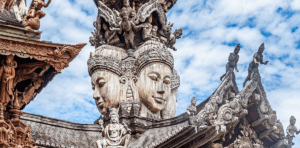
The Southern Hall is centered around astronomical themes of the Sun, the Moon, and the Stars – the three creators of life. The Sun controls the day and night, the Moon controls the tides, while the Stars control your destiny. Each star (planet) represents a day of the week, and depending on which day you were born, you are destined to have a specific trait:
Monday – Moon – Beauty and Elegance
Tuesday – Mars – Brave and Industrious
Wednesday – Mercury – Gentle and Polite
Thursday – Jupiter – Wisdom an Intelligence
Friday – Venus – Charm and Wealth
Saturday – Saturn – Activeness and Diligence
Sunday – The Sun – Honorable and Social
The Northern Hall depicts the teachings of Taoism and Confucianism. It reflects on the Buddhist beliefs that even though the people are born different, if they make merits and do good, they would be liberated from vices, greed, and passion, and reach Nirvana.
The Central Hall features a magnificent wooden throne. There are no deities at the gates around it, which symbolizes a liberation, timeless truth, and harmony. It also urges us to cleanse our hearts and follow the five precepts of Lord Buddha – to abstain from killing, stealing, adultery, lying, and vices (alcohol, opiates, gambling).
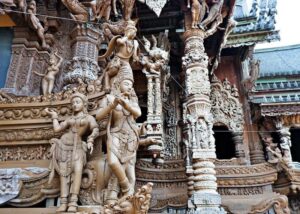
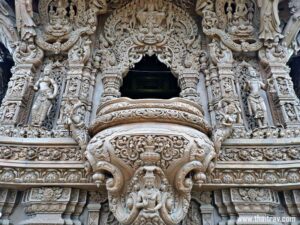
The Sanctuary of Truth: its construction began in 1981 and is still an unfinished museum, is still in construction, though visitors are permitted inside wearing hard hats. Visitors need to wear the safety helmet provided when touring the facility with an assigned guide.
Mr. Viriyaphan wanted to spread message to all the people to behave well, according to Buddhist teachings, so that we can achieve peace around the world.

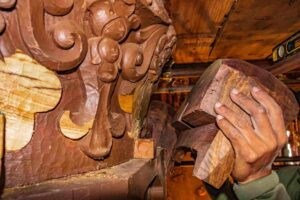
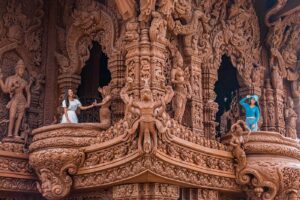
References:
** https://sanctuaryoftruthmuseum.com/
** https://www.agoda.com/
** https://globalcastaway.com/sanctuary-of-truth-pattaya
** https://www.tourismthailand
** Wikipedia
******

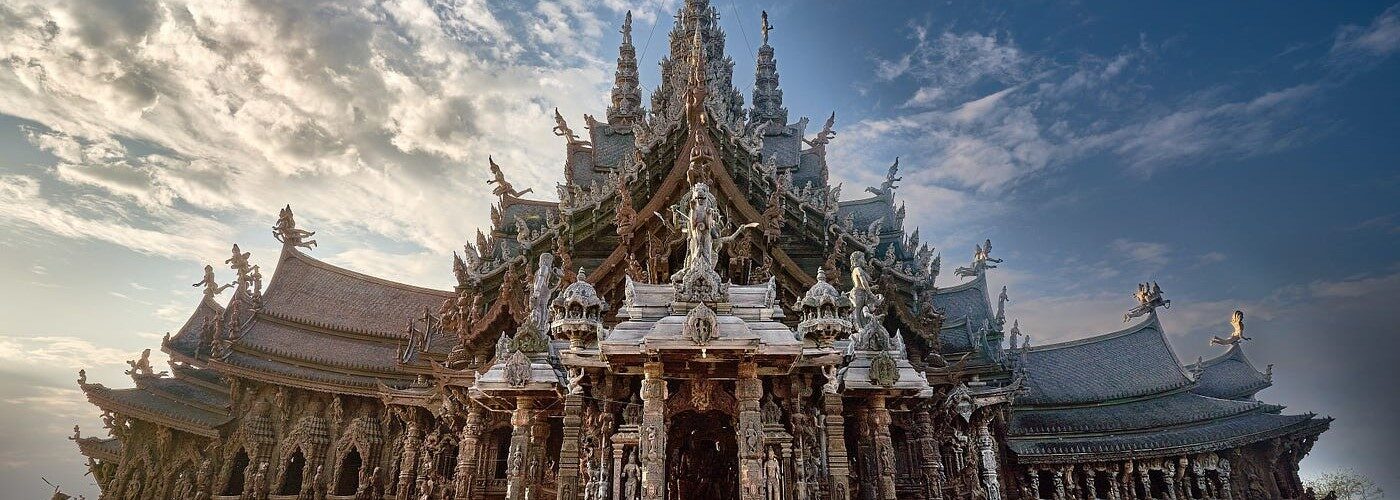

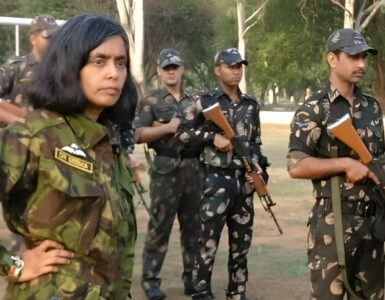










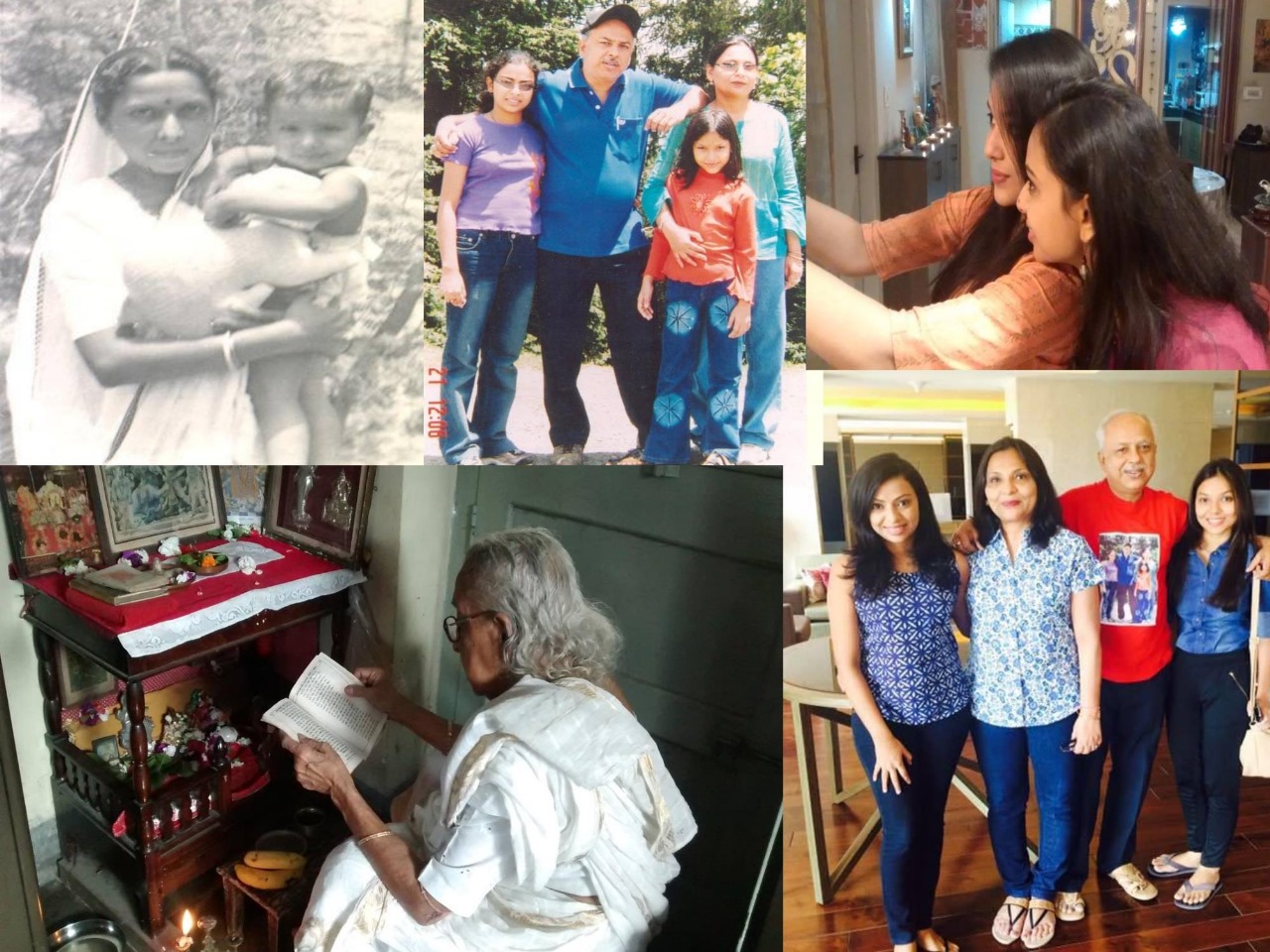
Sanctuary of Truth সম্বন্ধে জানা ছিল না। সমৃদ্ধ হ’লাম। মাস কয়েকের গ্রামাঞ্চলে কাটাবার ব্যাবস্থা করার নানান কাজের ভীড়ে পড়তে সময় করে ওঠতে সময় লাগল।
Enlightened. All your articles are written after extensive research.The subject matters not in common public domain. Interesting and enjoyable reading the article. God bless you
“The Sanctuary of Truth” – honestly was not known to me until now.
Though it is not very old and is still in making, the concept is unique and appreciable, specially in this ‘Kalyug’.
Wish the “Truth” flows in here from celestial acts and then travels from here to upgrade our humanity.
The intrecate architecture and construction of the structure, depicting spirituality, are beyond expectations and too comforting.
Kudos to Asim, for extracting such beauty and enrich us with such marvel .
Asim,
Thanks for sharing it, one more nice article of yours.
It’s wonderful idea to build a temple not for any particular religion, but for spiritual unification of different religious thoughts into a single belief: peace and love for all.
A nicely composed write up.
The pictures are superb.
Thanks
Nice one.
I think it is not well marketed by the sanctuary authority. I had been to Thailand, I love visiting such places but my travel operator never shared about it.
Anyway, your article is well written and interesting enough, worth reading.
Thanks.
Nice to read your article Sanctuary of Truth. I have neither read about this structure nor heard about it eatlier. Thanks Asim for bringing many unknown (to me) marvels of the world particularly which are located at remote places of third world countries.
Well written 👏🏻👏🏻
দারুন লেখা হয়েছে। প্রচুর তথ্য দিয়ে লেখা। পড়তে পড়তে মনে হচ্ছিলো আমি ওখানে পৌঁছে গেছি। আরো পড়তে এবং জানতে ইচ্ছে করছিলো কিন্তু দেখলাম হটাৎ লেখাটা শেষ হয়ে গেলো। লেখক কে অশেষ ধন্যবাদ এতো সুন্দর করে এই অপূর্ব শিল্পকলা এবং সৌন্দর্যের কথা লেখার জন্য। সাথে বেশ কিছু ছবিও আছে, তাতে কি ধরণের কাঠের অসাধারণ কারুকার্য করা হয়েছে সেটা বোঝা যায়। শিল্প কর্ম অসাধারণ এবং তুলনাহীন। যদি সম্ভব হয় ওখানে যাবার ইচ্ছে রইলো। লেখক কে আমার শুভেচ্ছা রইলো এবং ভবিষ্যতে আরো এই ধরণের লেখার জন্য আবদার রইলো।❤🌹
চমৎকার লেখা ।
আমি আর জুলী এখানে গেছি।
মনে আছে পাতাইয়া যাবার রাস্তায় চোনবুড়ীতে।
অসাধারণ অভিজ্ঞতা ।
তুই লিখেছিস দারুণ । যারা যায়নি তারা লেখাটা পড়ে উপকৃত হবে ।
There exists a museum of art and religion but not propagating any particular religion, rather promoting the essence of spirituality. First reaction is –could it be possible to sustain in such a strife torn time? that too not a very ancient one. Rather, it is being constructed since 1981 till date.
But this article of Asim Deb, full of reference of source material and some excellent photographs, convinces us that it has been existing in Thailand and named as “Sanctuary of Truth”.
Truth! in this age of post truth and deep fake who cares about truth?
However, some are certainly caring. Hence this ever growing museum full of Hindu, Shaiva , Buddhist and Khamer motifs, and constructed only with woods.
Am not sure of visiting the said place because of old age. Yet, this makes me wishing for living a longer life. World is full of wonders.
The write up vividly captures the Sanctuary of Truth’s Architectural grandeur, cultural fusion and philosophical depth. It skillfully blends historical context, artistic details and symbolic meaning, presenting the site as a universal monument of peace, love and spiritual unity beyond religious boundaries. Another colourful bead in the garland of creative writing by author Asim Deb.
পড়লাম। খুব ভালো লাগলো। জানা ছিল না। শুধু এটুকু জানতাম, থাইল্যান্ড বালির কাঠের কাজ বিষ্ময়কর।
লেখা ও ছবি , দুটোই খুব ভালো। এই সমস্ত শিল্পীদের কাজ অবাক করা।
‘Sanctuary of truth’- what a wonderful concept. A massive monument is being made with wood carving and sculpture. No nail was used to hold massive structure.
It attracts the concept of uniting multi-religious philosophy in one monument. It reminds me of making one religion ( Din – E – llahi) out of multi religions’ vurtues conceptualised by our Great king Akbar . However the concept was fizzled out after his death. It may not be out of context to mention that once Buddha advised his disciples not to make his statue and worship. Instead follow his life philosopy. That did not happen after his death.
Finally I congratulate you again for bringing unusual subjects for our enlightment.
From the write up , author has made it clear that, tt’s more than just a building; it’s a cultural center that aims to convey moral teachings and artistic expression. Wonderful and please keep enlighten us.
পড়লাম। ভারতীয় দর্শন ও বৌদ্ধ দর্শন বহুক্ষেত্রেই সমগোত্রীয়। তবে মঠের নয়নাভিরাম সৌন্দর্য ও দার্শনিক ব্যাখ্যা দুইই সমান আকর্ষনীয়।
I see this is as a work of art with impeccable craftsmanship, not withstanding the universal message it portrays through this wonderful architectural brilliance. We get to see similar craftsmanship wonders in temples of India, which other wise mystifies us that how could someone erect a structure like what it is. One of its kind is Jagannath temple of Puri. Good to see Dada, you are devoting so much of time and intellectual energy in digging out the wonders of this planet before us. Carry on with best wishes to learn so many of these in your upcoming posts.
The Sanctuary of Truth সম্বন্ধে এত বিশদ ভাবে আগ কখনও জানতাম না। অনেক তথ্য সমৃদ্ধ এই বিবরণ পড়ে স্বচক্ষে দেখার ইচ্ছে প্রবল হল।এই বিশাল কর্ম কান্ডের যিনি উদোক্তা তার প্রতি অনেক শ্রদ্ধা জ্ঞাপন করি।
লেখককে অনুরোধ করব ভবিষ্যতে এরকম অনেক অজানা জায়গার বিবরণ তুলে ধরে আমাদের জ্ঞান সমৃদ্ধ করবেন।
খুব ভালো উদ্যোগ।
আজ ধর্মের নামে রাজনীতি আর হিংসার মাঝে একজন উদ্যোগী প্রচুর অর্থ ব্যয় করে শান্তির ধর্মকে প্রচার করছেন, জেনে ভালো লাগলো।
লেখককেও ধন্যবাদ। এরকম একটি সর্বধর্মের মন্দির যে আছে, জানা ছিল না।
Well written article on a subject of universal interest of mankind with universal questions of life. I would have liked to see the structure when visited Pataya the place that attracts the tourists for other materialistic interests.
The construction, as mentioned by the author has started in 1981. Is it reconstruction on an existing structure or a new one? If it is new, I think, it will take a long time to complete. Unfortunately, as now I am quite old, it will be possible for me to see the temple personally.
Thanks Ashim for the article.
Never heard of it. Simply superb, as usual. 👍
As usual nice write up Dada. Never heard of this temple. An amazing temple of Pattaya. 👏👏👏
Prasat Satchatham or the Sanctuary of Truth is a recently built Thai structure with flavours of the medieval India. Made of wood and only wood this massive structure with intricately built figures mostly depicting Buddhist themes with some Hindu ideas intertwined, carries message so surreal that I still could not master it after reading several times. I understand the dedication and love of the author to make this extremely difficult article easy and interesting for the readers. Thanks Asim for this wonderful treatise on an extremely interesting subject
Again an article on entirely different topic, and well researched and informative as well.
From time immemorial, clash and bloodshed occured in this world, for sake of religion.
In that perspective, this endeavour is really praiseworthy.
This apart, the skill, labour, dedication, involved in erection of such a huge wooden structure, too is commendable.
Thanks again for such an article.
প্রতিদিন একটা নতুন অজানা জানতে ভালো লাগে ….. আজকে এই অজানাকে জানলাম । আবার কোনো দিন ওখানে গেলে অবশ্যই দেখে আসবো তবে এই লেখা আমার না দেখাকে দেখতে ও জানতে সাহায্য করলো ।
আরো অজানাকে জানার অপেক্ষায় থাকলাম।
Sanctuary of Truth,is a castle made up of beautiful wood carvings,very intricate indeed, at Pattaya Town in Thailand,otherwise known for its vibrant night life..Its main structure,one hundred thirty metre high is visible from far away. It is so gorgeous in looks similar to famous golden Buddhist temple in Bangkok. Though I have not seen this Sanctuary of Truth,it is really an wonderful man made creation to be finished by 2030.The concept of this castle is based on Hindu &,Buddhist philosophy. Concept of North Hall,spirituality is akin to our Bramho Mandir concept,where there is no idol at all.
Walls of this Sanctuary is so elegant that one can’t take off one’s eye from it.
Beautiful story.
The Thailand society is remarkably split into two main types, one is traditionally Buddhist belief and faith and lifestyles. The other is nightlife which is very tempting for a large section of people. In such contradictory society, innovation of such concept, a Sanctuary of Truth is an outstanding effort.
Though, I doubt if such a great effort is well publicized outside Thailand. Thanks to my author for bringing our such an amazing article. The text is very precise, and photos are superb.
Nice to read it. Thanks
i was not aware of “sanctuary of truth” museum. Normally we consider museums as old and traditional. But it is still under constuction, hence architectural theme or composition is different from conventional museum.
It is a blending of spiritual and religious belief and concept.
Good write-up with lots of snap capturing the museum aesthetic nicely.
This is incredible piece of knowledge.
Though I had some information about ancient structure in east Asia but honestly, I never knew about something of this sort. The “Sanctuary of Truth” temple has shown the brilliant display of spiritual side of humans life through the ‘Halls’. Apart from this, the scenic beauty of the wooden crafts is a joy to the eyes.
I sincerely wish to have more from the pen of the writer.
Best wishes.
পড়লাম। অনেক কিছু জানলাম। 105 মি উচু কিন্তু কোন রকম লোহার পেরেক ছাড়া কি ভাবে দাড়িয়ে আছে ভাবলে অবাক লাগে। এমন অজানা তথ্য জানাবার জন্যে অসীমকে অনেক ধন্যবাদ l
অসীম ভাই, আমি ভুলেই গেছিলাম, তুমি আমাকে এই article টা পাঠিয়েছিলে। মনে করিয়ে দেবার জন্য জানাই অশেষ ধন্যবাদ।
আমি article টা পড়লাম। ভারী সুন্দর তোমার উপস্থাপনা। বুদ্ধিষ্টদের বেশীর ভাগ শিল্পকর্ম কাঠের উপর খোদাই করা কাজের মধ্যেই নিহীত আছে। তোমার বর্ণনা আর ছবির মধ্য দিয়ে নতুন করে কাঠের কাজের এক নতুন পরিসংখ্যান দেখলাম।
The Sanctuary of Truth এর আর একটু ব্যাখ্যা দিলে বোধহয় রচনাটা আরও জমে যেত। তখনকার সমাজে এই সাতটি সত্যের সমীকরণ কিভাবে প্রতিফলিত হয়েছিল,সেটা জানার অপেক্ষায় রইলাম।
তবে মন্দিরের architectural ব্যাখ্যাটা অতি সুন্দর ভাবে সাজানো হয়েছে। মন্দিরটি এখনও অসম্পুর্ণ। তোমার লেখার মাধ্যমে থাইল্যান্ডের একটা সংস্কৃতির সুন্দর চিত্র পেলাম।এটা কি পৃথিবীর একটি আশ্চর্য্য স্থাপত্য এবং ভাস্কর্য্যের নিদর্শন হিসাবে গণ্য হতে পারে ?